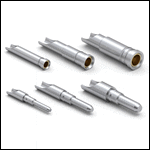Rectangular Connectors for Mil/Aero Disconnect Applications
While circular connectors are often the go-to choice for mil/aero applications, rectangular connectors may be an alternative under certain conditions.
Circular connectors have been a mainstay in the military/aerospace market segment for more than 75 years, but there is another option for your disconnect application. Governed primarily by the MIL-DTL-5015 and MIL-DTL-38999 specifications, circular connectors have evolved throughout the years in terms of shell base material/finish options, coupling mechanisms, the expansion of contact choices, and an increased range of contact voltages and currents, for example. The one constant, however, is the need for space surrounding the connector to allow the operator’s hand to lock/unlock the mating connectors.
Today’s suppliers face challenges that differ from their predecessors, especially when discussing usable panel space. Equipment may continue to decrease in size but not necessarily in the amount of inputs/outputs. Designers who want to use an array of connectors to meet these demands have found that rectangular connectors are a possible alternative to resolve such issues.
The idea of rectangular connectors being solely for rack-and-panel applications is an outdated notion. Their use in disconnect applications has been practiced in military/aerospace markets for quite some time. However, some design engineers still struggle to get comfortable with their use. Those using products such as EN4644 or EN4165 immediately see the value when they create high-density solutions, perfect for panels requiring an array of connectors for both cable-to-cable and PCB-to-cable applications.
Most rectangular connectors do not require the same amount of room as circular connectors for mating/unmating because most are equipped with a central locking feature. This locking functionality allows stacking of most rectangular connectors to provide better contact density. The net result of stacking these connectors is a reduction in panel size, which consequently lowers the panel weight. The weight savings can further be optimized with the use of composite or other lightweight shell options.
Over time, rectangular connectors have evolved to include shell base materials/finishes similar to circular connectors and can accommodate the same range of contacts (signal, power, high frequency, Ethernet, and fiber optics). Modularity is another key feature manufacturers have introduced, which gives customers flexibility for design changes. This capability is achieved with removable inserts, addition of grounding features, and rear accessories for strain relief/EMI shielding. These solutions have proven to be a cost-effective option for harness installation as connector shells may be pre-mounted while inserts are populated with contacts prior to installation. Those still unsure about rectangular connectors can use a hybrid approach. A few manufacturers are producing connectors with rectangular interfaces that have circular outputs, which accommodate standard 38999 rear accessories.
Circular connectors are not going to disappear any time soon as their foothold in the military/aerospace markets is well documented. However, expect to see increased use of rectangular disconnects as panel space continues to diminish. By combining these space-saving solutions with the expanding modular options, your design team will have the flexibility they need to be successful.
Author Travis Warmouth is a field application engineer for Radiall.





